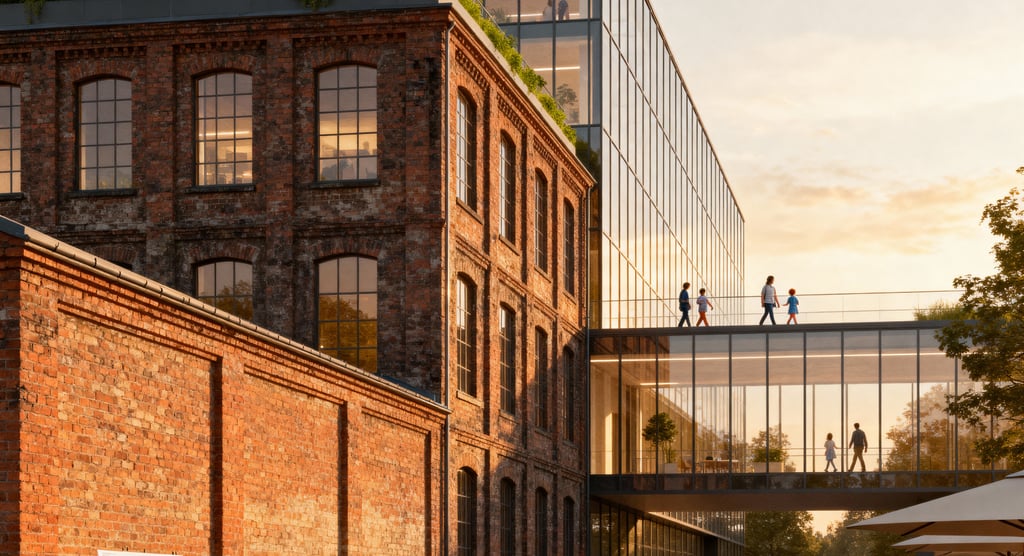Quality and technology IN CONSTRUCTION
delivered with STRAIGHT communication
Multifunctionality and Adaptive Reuse: Creating Value Instead of Demolition
Adaptive reuse and multifunctional design are transforming construction: keep buildings, give them new life. It’s cheaper, greener, and smarter. The future value lies in spaces that can change.
CONSTRUCTIONTRENDPROJECTMANAGEMENTFUTURESUSTAINABILITY
Dr. Toldy Gábor - Toldy Construct
10/27/20254 min read


Multifunctionality and Adaptive Reuse: Creating Value Instead of Demolition
What is this all about?
Our built environment faces two major challenges:
A growing stock of partially vacant or outdated buildings (offices, shopping centers, industrial facilities).
The “tear down and rebuild” reflex, which wastes both money and environmental resources.
The solution:
Multifunctionality (multi-use): a single space can serve multiple purposes – work by day, living or community use by night; a school that becomes a community center after hours; an office easily converted into housing.
Adaptive reuse: keeping and upgrading an existing structure while giving it a new function (e.g., office → residential, warehouse → cultural center).
In essence: what already stands should first be adapted, not demolished.
Demolition should be the last resort.
Why is it worth it?
1) Environment: saving “embodied carbon”
New construction carries enormous hidden carbon costs — cement, steel, manufacturing, transport, and demolition waste.
International studies show that retaining and upgrading an existing building can save 4–46% of total environmental impact in the early life cycle compared to new construction — depending on building type and climate.
That’s the first major gain.
(Source: Living Future Institute – “A Future Worth Living In”)
2) Finance: shorter timelines, lower risks — if properly planned
In many cases, keeping the primary structure is cheaper and faster than building from scratch.
It reduces permitting uncertainty and construction exposure — provided that the conversion is well designed from the start (light, evacuation, MEP, fire safety).
According to the 2025 ULI report, adaptive reuse has a solid business case, if the project meets genuine urban demand and not just aesthetic ambition.
(Source: knowledge.uli.org)
3) Urban policy: success follows strong incentives
New York City began turning underused post-pandemic office buildings into housing through targeted tax breaks and zoning reforms.
By Q1 2025, the city comptroller’s office listed 44 completed, ongoing, or planned conversions, totaling 15.2 million gross square feet.
This is not an anecdote — it’s a structured program driven by 2024 regulatory changes.
(Source: comptroller.nyc.gov)
The private market reflects this shift as well:
by August 2025, 4.1 million square feet of new conversions had started — more than in all of 2024 — and 8.8 million more were in the pipeline for post-2026.
(Source: Cushman & Wakefield)
A working model: London’s Battersea Power Station
An iconic industrial giant that was not demolished.
Battersea Power Station became a mixed-use district — housing, offices, retail, and culture — with a new metro connection.
Two quick facts:
Opening: October 2022 — over 22 million, then 30 million visitors (as of September 2024 and May 2025). This is rare real-world validation.
Lesson: multifunctionality only works if it’s backed by mobility access and a planned tenant mix. Battersea had both — that’s why it works.
(Source: batterseapowerstation.co.uk)
Multifunctionality in homes and public buildings — what makes it usable?
“Multi-use” is not a decorative concept — it’s a system:
Temporal mix: the space should be active both day and night (services + housing + community).
Acoustics, fire safety, utilities: these are the critical risk points — cutting corners here will backfire.
Accessibility: pedestrian, cycling, and public transport links turn a building into a real destination.
In smaller residential projects, modular design provides flexibility:
movable partitions, track lighting systems, and zoned HVAC.
Home renovation experts highlight the same principles — prioritize adaptable layouts and convertible “utility” zones.
(Source: Mitchco Group)
For industrial or institutional scales, dry construction and modular MEP systems are key to rapid transformation.
Steel and lightweight structures are preferred in adaptive projects due to their flexibility and recyclability.
(Source: METALCON)
Critical filter: when not to force it
Deep floorplates, low ceilings, poor core layout — office-to-residential may not make sense here.
British experience confirms this: not every tower makes a good home; lack of daylight and fire egress often block conversions.
(Source: The Guardian)Policy vacuum: without tax or zoning incentives, the numbers don’t work — that’s why NYC only accelerated after the 2024 reforms.
(Source: comptroller.nyc.gov)“Everything must be flexible” trap: too much universality is expensive and unnecessary.
Focus flexibility where change is likely — tenant areas, wet zones, utility cores.
Quick decision checklist (for developers, municipalities, institutions)
1) Keep or demolish?
Assess structural condition + light/egress/MEP checklist.
Conduct a preliminary LCA (keeping the structure offers the biggest CO₂ savings).
Financial comparison: demolish + rebuild vs. retain + refurbish.
(Source: Living Future Institute)
2) Functional mix: balance daytime and evening use; ensure acoustic and fire zoning strategies.
3) Modular infrastructure: dry walls, track lighting, and zoned mechanical systems.
(Source: METALCON)
4) Map incentives: tax relief, zoning flexibility, accelerated permitting — without these, conversion waves rarely take off.
(Source: comptroller.nyc.gov)
5) Connectivity: without transport links, multifunctionality is just theory.
(See Battersea — new metro line.)
(Source: Battersea Power Station)
Practical tip – how to make your renovation more adaptable
Walls: dry construction, repeatable modules → fast tenant change, minimal demolition.
Lighting: track systems + DALI/PoE control → no rewiring during function change.
MEP: zoned, plug-and-play systems (e.g., VRF), suspended ceilings → cheaper reconfiguration.
Materials: steel and other demountable components → circularity + fast assembly.
(Source: METALCON)
Closing thought
Multifunctionality and adaptive reuse are not styles — they’re strategies.
They deliver less CO₂, lower risk, and faster market entry.
Demolition is often the lazy option.
Those who fail to consider reuse today are burning not just capital, but social value.
Key References (supporting the article)
Environmental impact / LCA: The Greenest Building – Quantifying the Environmental Value of Building Reuse, National Trust for Historic Preservation / Preservation Green Lab — 4–46% life-cycle savings depending on case. (Living Future Institute)
Business case / case studies: ULI (2025) – What’s Old Is New: The Business Case for Adaptive Reuse, framework and financial results. (knowledge.uli.org)
NYC office→residential conversions: NYC Comptroller (2025) – 44 projects, 15.2M ft²; Cushman & Wakefield (2025) – 4.1M ft² new conversions, 8.8M ft² pipeline.
London, Battersea Power Station: official communications on visitor numbers and 2022 opening. (batterseapowerstation.co.uk)
Industrial / institutional technologies: METALCON trend and trade reports on modular and prefabricated construction.
Residential multi-use tips: Mitchco Group – modular thinking, universal design, adaptable layouts.
Trends and regulations (North America): USGBC (2024–2025) – policy brief on conversions and incentives.
Critical limits (UK): The Guardian – why not every office is suitable for housing (daylight, depth, standards).
Construction
With over 20 years of experience in general contracting, our company specializes in the flawless execution of unique, bespoke buildings. Our innovative methods and mindset make us stand out in the market.
Our services
Contacts
company@toldyconsult.hu
+36 30 289 2383
© 2024. All rights reserved.
Our WEBPAGES
www.toldyconsult.hu
